Arizona Vegetable & Fruit Gardening
For The Arizona Desert Environment.
Pictures, Photos, Images
Descriptions, Information, & Reviews.
Vitis riparia
Vitis rotundifolia & Vitis amurensis.
We Are Proud Of Our SafeSurf Rating!
Click On The Item For A More Detailed Look. No Obligation!
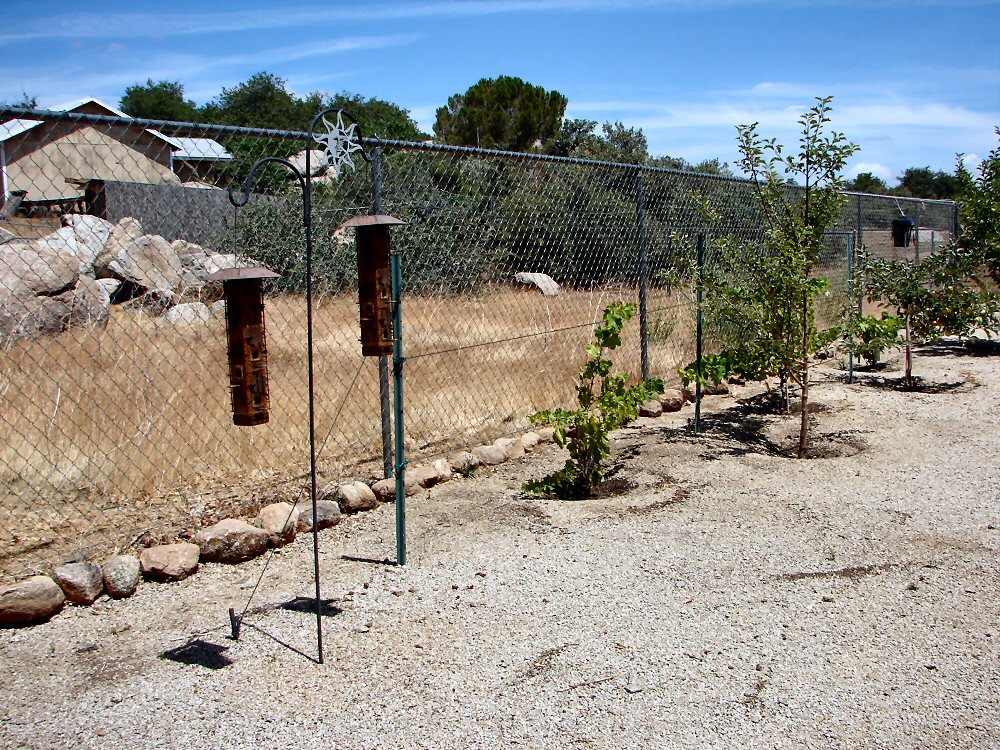 |
| Grape Vine Trellis Of Steel Fence Posts & Coated Wire. New Two Year Old Thompson & Flame Seedless Grape Vines Planted On April 20, 2011, In A North - South Line Angle. Photo Taken July 11, 2011 In Yarnell, Arizona. |
|---|
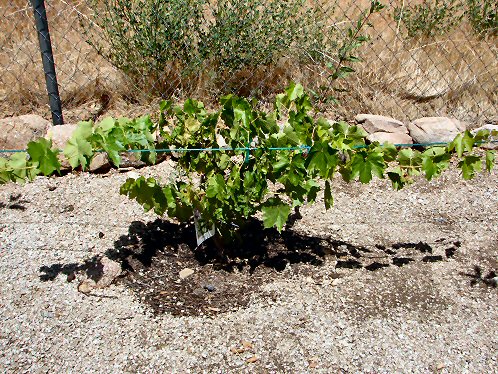 | |
| New Two Year Old Thompson Seedless Grape Vine, Vitis vinifera. We Are Forming A Framework Of The Vine Itself By Loosely Tying Branches To Wire Supports. | New Two Year Old Thompson Seedless Grape Vine, Vitis vinifera. This One Is Not Growing As Fast. We Are Starting The Lower Two Branches At The Winter Pruning We Will Reshape. |
|---|---|
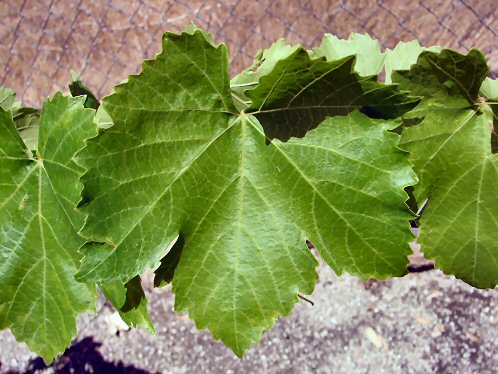 | |
| New Two Year Old Thompson Seedless Grape Vine, Vitis vinifera. Leaf Structure. | New Two Year Old Thompson Seedless Grape Vine, Vitis vinifera. Tendrils Seen Holding Graprvine Arms or Cordons To Wire Of Fence. |
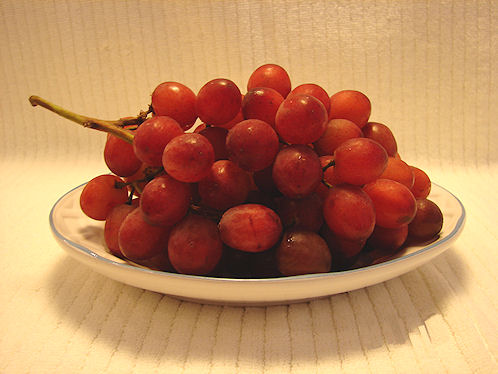 | |
| Thompson Seedless Grapes, Vitis vinifera. Fruit. | Flame Seedless Grapes, Vitis vinifera. |
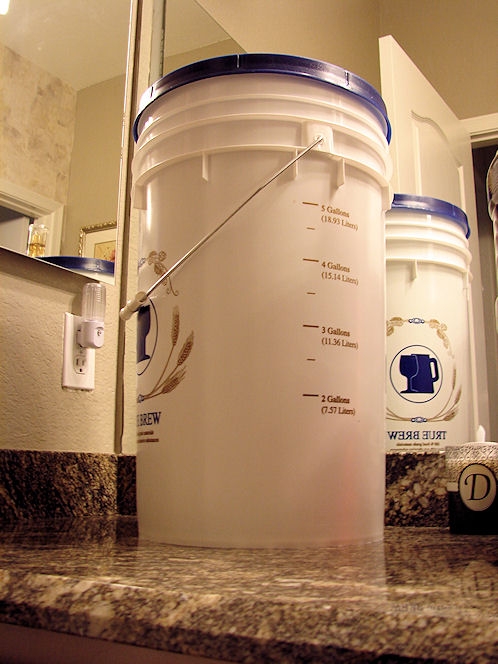 | 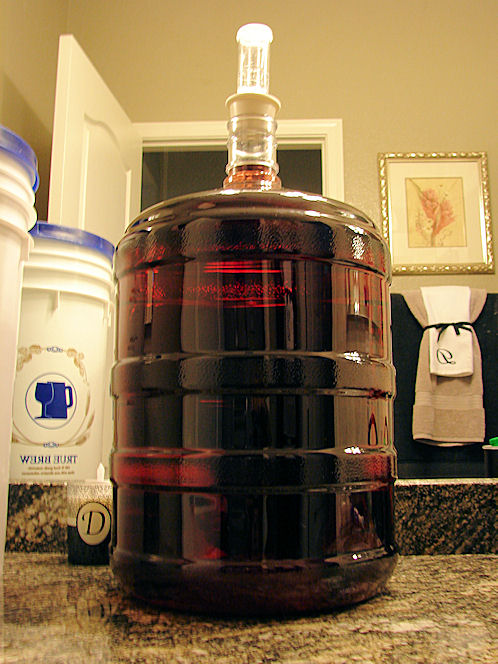 |
| Home Wine Making Equipment. Making Wine. Using Our Own Grapes. 6 Gallon Wine Fermenter. | Home Wine Making Equipment. Making Wine. Using Our Own Grapes. 6 Gallon Wine Carboy. |
|---|---|
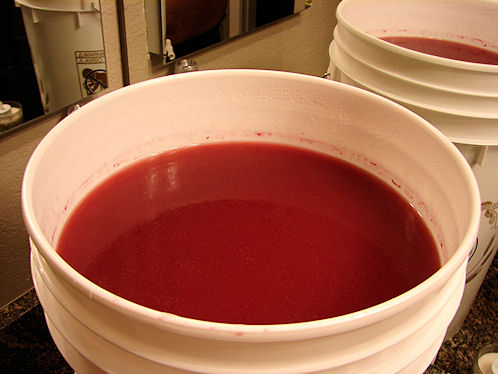 | 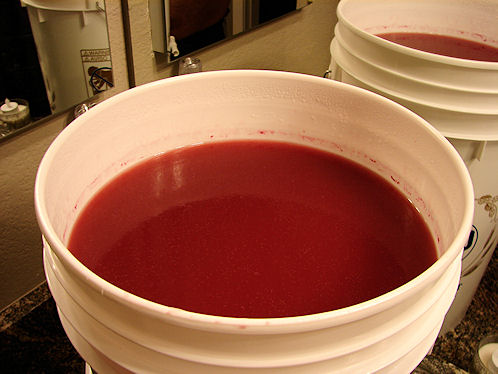 |
| Making Wine. Using Our Own Grapes. Here The Wine Is Fermenting. The Grainy Appearance Is From Carbon Dioxide Gas Bubbles! | Making Wine. Using Our Own Grapes. Here The Wine Is Fermenting. The Grainy Appearance Is From Carbon Dioxide Gas Bubbles! |
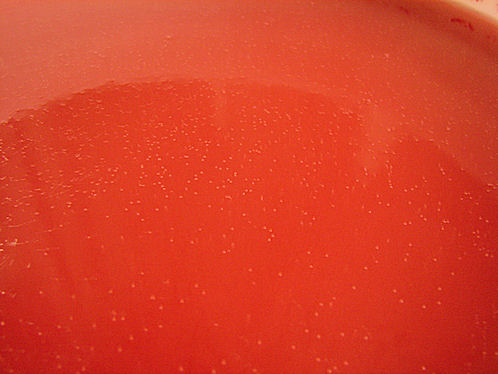 | 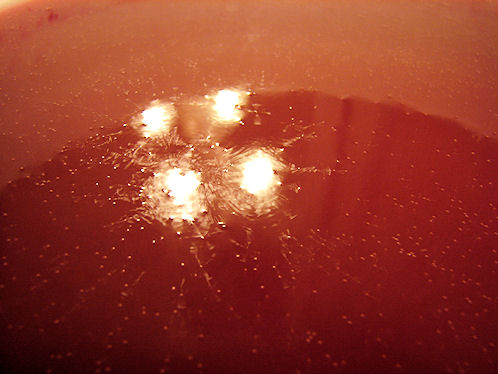 |
| Making Wine. Using Our Own Grapes. Close Up Of The Wine Fermenting. The Grainy Appearance Is From Carbon Dioxide Gas Bubbles! | Making Wine. Using Our Own Grapes. Close Up Of The Wine Fermenting. The Grainy Appearance Is From Carbon Dioxide Gas Bubbles! |
 |  |
| Finished Homemade Wine. | Finished Homemade Wine. |
That We Personally Have Used &/Or Recommend,
Click On The Item For A More Detailed Look. No Obligation!
That We Personally Have Used &/Or Recommend,
Click On The Item For A More Detailed Look. No Obligation!
Grape Vines.
History Of Grapes:
It is thought that the history of the grape is at least as old as the history of mankind. The earliest grape consumers were probably hunter/gatherers who included the wild grape in their diet Archaeologists tell us that grapes were one of the earliest cultivated fruits on the Earth. It is thought that the grape that we call. vitis vinifera originated in the Black Sea region and spread rapidly southward to the Middle East. Archaeologists best estimates are that grapes were being cultivated in northern Mesopotamia as early as 6,000 B.C. in today's country of Georgia. Here ceramic wine jars were found in what was once a Neolithic village dating back to 6000 B.C. Click here to read the report by James Owen for National Geographic News Published January 10, 2011 of the find with photos of the world's oldest known winery, near the village of Areni at the Areni-1 cave complex. Other references can be found in Iran, dating back to 5000-5500 B.C. This evidence may suggest that winemaking originated in present-day Georgia and then spread south. From there, the vinifera grape spread eastward into Phoenicia and Egypt. Hieroglyphics depict vines in ancient Egypt's burial tombs: winemaking was widely practiced in Egypt in 3000 B.C. The first references of the domestication of grapes can be found from about 3,200 B.C. By 2,000 BC, Phoenician sailors were carrying grapevines across the Mediterranean Sea into Greece and the world beyond. Grapes were grown for winemaking from the beginning of our written history, but the ancient Greeks were the first civilization to make a serious practice of grape growing and winemaking. The ancient Romans refined the art of grape-growing and processing. They introduced pruning by knife, proper filtering, and storage methods. The art of grape-growing declined along with the fall of the Roman civilization and after about 400 A.D. Only the Catholic Church kept the practice alive through the Medieval times, in particular the Benedictine and Cistercian abbeys of France and Germany.
Types Of Grapes:
As our knowledge of plant biology, grape vine grafting, and hybridization expanded, so did the varieties of grapes and their uses. Now there are "table" grapes grown especially for eating. "Dessert" grapes. Raisin grapes. And of course, the many varieties of wine grapes. With the advent of pasteurization and the pioneering work of Dr. Thomas Bramwell Welch in 1869, unfermented grape juice has now became a popular beverage. Most of our grapes come from the cultivars of Vitis vinifera, the European grapevine, which is native to the Mediterranean and Central Asia. Minor amounts of fruit and wine come from four other American and Asian species: Vitis labrusca: the North American table and grape juice grapevines (including the concord cultivar), which are sometimes used for wine. They are native to the Eastern United States, and Canada. Vitis riparia: a wild vine of North America, which is sometimes used for winemaking and for jam making. Vitis riparia is native to the entire eastern U.S. and north into Quebec. Vitis rotundifolia: the muscadines, which are used for jams and wine. They are native to the southeastern United States from Delaware to the Gulf of Mexico. And Vitis amurensis: which is the most important Asian species. The grapes that we eat or make into juice or wine are a type of berry that grows in clusters of 15 to 300 berries to a cluster, and can be crimson, black, dark blue, yellow, green, orange, and pink. "White" grapes are actually green in color, and they are evolutionarily descended from a purple grape Most consumers of grapes prefer to eat seedless grapes; seedless cultivars now make up the overwhelming majority of table grape plantings. Because grapevines are vegetatively propagated by cuttings, the lack of seeds does not present a problem for reproduction. There are several sources of the seedlessness trait, and essentially all commercial cultivators get it from one of three sources: Thompson Seedless, Russian Seedless, and Black Monukka, all being cultivars of the grape vine Vitis vinifera. There are currently more than a dozen varieties of seedless grapes.
Nutrition Of Grapes:
Grape's are excellent for eating out of hand and in salads. Grapes are also very low in calories. 100 grams of fresh grapes have only 69 calories but zero cholesterol levels. Grape's are an excellent source of vitamin C, vitamin A, vitamin K, carotenes, B complex vitamins such as pyridoxine, riboflavin and thiamin. Grape's phytochemical compound resveratrol, a polyphenol anti oxidant, has been found to be protective against cancers of colon and prostate, coronary heart disease (CHD), degenerative nerve disease, Alzheimer's disease and viral or fungal infections. Grapes are rich source of micro-nutrient minerals like copper, iron and manganese. Copper and manganese are an essential co factor of antioxidant enzyme superoxide dismutase. Iron is specially concentrated more in raisins. In addition 100 g of fresh grapes contain about 191 mg of health benefiting electrolyte, potassium. Anthocyanins, another class of polyphenolic anti oxidants, found abundantly in red grapes shown to have anti allergic, anti inflammatory, anti microbial and anti cancer activities. Catechins, a type of flavonoids anti oxidants found in white or green varieties also shown to have these health promoting effects.
Growing Of Grapes:
Grow What Tastes Good To You.
This seems obvious, but select a grape that you have personally tasted and like! In 2010 we had to plant new grapes because we disliked the taste of the old ones. It seems that while they grew very well in our area, they were mislabeled at the nursery and were of a type that none of us liked!
Grow What Grows Well In Your Area.
This seems obvious, but select a grape that grows well in the area you live in! Your Cooperative Extension Service can offer advice. Contact them or your local nursery.
An excellent resource for how to grow grapes is the pdf version of "Grapes for Central Arizona" by the University of Arizona, Yavapai County Cooperative Extension, Click Here To Read A Copy.
Site Selection For Grapes: Select a site with fertile, deep, well-drained soil; where there is also good air drainage. The site should be where there is full sun. Proper selection and soil will save you from a lot of troubles, later on! In addition, a north-to-south slope with rows also running north-to-south exposes the grape vines to more sunlight and give your grapes the optimum sunlight that they need. Sandy loam soil is best. Avoid adobe soil. Slightly acid soil is also best. Optimum pH is 5.5 to 6.5. They will tolerate a pH up to 7.0. If your soil is below 5.5: bring it up to 6.0 or 6.5 with lime. If above 7.0: consider lowering it to 6.5 or 6.0 with sulfur, or by using acid forming fertilizers (ammonium sulfate). Grapevines can tolerate temperatures as low as 5 degrees Fahrenheit so growers in Arizona do not need to worry too much about grapes dying in the frost.
Planting Your Grapevines: The key is to spend some time on soil preparation before planting. Proper soil preparation will save you from a lot of troubles, later on! The soil should be dug as far down as you can go, I've even gone about three feet in some cases, just to loosen the soil and to make it so that I can add well rotted manure and mulch. Add well rotted manure and mulch. Its important that it should be well rotted because fresh manure will burn the vines roots. Another good source of organic matter is compost created from oak, ash and lime trees; beech leaves are best avoided, as they tend to be a little too acid for vines. Long ago in our history, before the Romans took an interest in vines; they grow naturally in woods and forests. They grew in natural forest mulch; which is why the requirement for lots of organic matter in the soil to recreate the leaf litter found naturally on a forest floor is key to growing grapes successfully. Next, plant your vines 6 feet to 8 feet apart. If you have more than one row of vines, plant your vines 12 feet apart between the rows. Then, have some sort of support in place for the annual growth and production of your grape vines. We use metal fence posts and a smooth coated wire line between the posts. Vines are sold as bare root or in pots. The same planting directions apply in either case. Make sure the root ball is not too much root bound or that it has been grown in a small pot for to long. If it has been so, you will know, because the roots will have started to spiral in the base of the pot. If it is root bound, you can try spreading the roots out a bit before planting into the hole. Don't spread out too much! The roots should be pruned only if they are damaged, as they contain stored food. Dig the planting hole wider and deeper than needed to accommodate the root system. After planting the vine, fill in the hole with a mixture of native soil, and well rotted manure and mulch, as needed to fill in the hole and vine to the same depth as the vine was in the nursery. DO NOT BURY THE GRAFT BUD of the vine. Next, water thoroughly. Do not add any fertilizer at the time of planting. Mulch your vines with either compost, well-rotted manure, straw, hay or leaves. The roots must be kept moist at all times for good results. The roots need to be kept cool and the water and mulch will accomplish that. Experts advise that tops of vines should be pruned back to 2 buds at planting time. Don't add fertilizer during the first year, as new plants are easily burned. It is very important to control weeds, as the competition will slow the growth of your grapevines. Irrigate your newly planted grapes often enough to keep the soil moist but not waterlogged. Timely irrigation, possibly once per week, is especially critical during the first year growing season. Once established, water grapes deeply, every 2 to 4 weeks. Apply enough water to wet the soil 3 to 4 feet deep. Allow the soil to dry out between waterings. The only fertilizer element that needs to be applied regularly is nitrogen. If using a commercial fertilizer, apply about 1/2 pound of ammonium sulfate per year to bearing grapevines. During the first two years you should concentrate upon forming a framework within the vine plant itself. This involves training the side branches and tying them to either wires or trellis supports. One of the key points in this operation is not to tie the vine too firmly as the branches will expand over the next two years and the ties might constrain the branch to much and cause some damage. Another important point is that by training the side branched horizontally this will help encourage fruit production later. During the first two-years of growth, we recommend feeding with a liquid feed once a month through the summer. This will help to create the grapevine frame work that will later support the grapes that are growing on the vine. The vine will produce fruit within the first two years! This next point may seem strange to you, but we suggest that this fruit is best left on the vine during the first two years; but it can be thinned by removing 2/3rds of the grapes that have formed within each bunch on the vine. This thinning should be done shortly after the grapes have formed after their blooming. The reason for this is that it will expose your grapes on the vine to better growing conditions. ie.. more sunlight, more room to expand. This is called cluster thinning. When removing clusters, seek out and remove those in the most shaded locations of the vine so that the retained clusters are in favored exposed positions. A study was done that showed that a thinned group of grapevines also started harvest 18 days earlier than an unthinned group. Finally, in the third year you can plan to produce some usable fruits. At the start of the year mulch the soil with some well rotted farmyard manure around the base. You should no longer be feeding with liquid feed during the summer. The grapes will form again on the fruiting spurs and should be thinned in each bunch this time by one 1/3. They will develop over the summer then in late July you should remove some of the vines foliage around the grapes to allow the more sunlight to ripen the bunches. Then, finally, when ripe, harvest your grapes!!! At the end of the year you should tie in the new shoots by cutting then back by 25% to encourage the formation of new fruiting spurs the following year. Protecting Your Grapevines From Cold Injury: If you live in an area that gets very cold; these suggestions may help! Develop vines with 2 trunks so when there is severe cold damage the least injured vine may be saved. Delay final pruning until after the extent of winter injury can be estimated. Do not allow excessive fruit load or vine size which delay maturity. Maintain healthy vines to promote earlier and more complete maturity of fruit which increases their cold hardiness. Plant only the most cold-hardy varieties. Select growing sites proven by your own experience to be warmer. ie.. more sunlight, protected from freezing.
Here are some of the more common but popular eating types of grapes:
The Thompson Seedless Grape, Vitis vinifera 'sultana' (also called: 'sultanina': Preferred Root Stocks, Dogridge (Vitis champinii) and Salt Creek (Vitis champinii): is a 12 - 18 feet long vine, a pale-yellow seedless grape. The sultana grape is cultivated in the United States under the name Thompson Seedless, named after William Thompson, a viticulturist who was an early grower in California and is sometimes credited with the variety's introduction. Thompson Seedless Grapes or sultanina grapes are also referred to as the �three way grape� because it is used for table grapes, raisins and wine. The White Thompson's Seedless Grape Vine is a favorite in U.S. grocery markets and is said to be the most popular seedless grape in the United States. The sultana raisin was traditionally imported to the English-speaking world from the Ottoman Empire. According to a popular folklore story from the Ottoman Empire, the sultana name was invented when the Sultan of the Ottoman Empire, left his grapes in the sun after fleeing a tiger attack, thus the name sultana, from the feminine form of the name sultan.
The Flame Seedless Grape, Vitis vinifera 'sultana' (also called: 'sultanina': Preferred Root Stocks, Dogridge (Vitis champinii) and Salt Creek (Vitis champinii): is a 12 - 18 feet long vine, a medium-large red seedless grape with a sweet flavor. The Flame Seedless was first introduced in the 1970s. It is the second-most popular grape in the United States. Its good qualities, especially seedlessness, sweetness, and long shelf life, make it very popular with farmers as well as consumers. The Flame Seedless is a vigorous, heavy-bearing table grape cultivar that keeps well in storage. It is a hybrid of Thompson, Cardinal, and several other Vitis vinifera cultivars. It produces large clusters of medium-large red grapes with a sweet flavor. Flame Seedless requires a long growing season. As such, the plants fare poorly in cool, damp zones. Thus, it does well in Arizona and some parts of California. To be of good-quality, it must be plump, well-colored, and firmly attached to the stem. The grapes are usually picked ripe, as they do not ripen after harvest. This makes it a great grape for the home grower. Flame Seedless grapes are ready to be picked in the middle of June and are an excellent variety for the Phoenix Arizona area.
The Sultana Grape, Vitis vinifera 'sultana' (also called: 'sultanina': Preferred Root Stocks, Dogridge (Vitis champinii) and Salt Creek (Vitis champinii): is a 12 - 18 feet long vine, a medium-large red seedless grape with a sweet flavor. The term "Sultana Grape' is used for the Thompson Seedless Grape or the Flame Seedless Grape.
The Muscat Grape, Vitis vinifera 'valvin': Preferred Root Stocks, (Courderc 299-35 x Muscat Ottonel) formerly NY62.0122.01): is a 12 - 18 feet long vine, is mid-season white wine grape with a distinctive muscat flavor. Produces a high aromatic varietal wine. Own rooted vines are small, averaging 1.1 lb/vine at Fredonia. The Muscat variety of grapes of the species Vitis vinifera is widely grown around the world for wine, raisins and table grapes. Their color ranges from white to near black. Muscat almost always has a pronounced sweet floral aroma. The breadth and number of varieties of muscat suggest that it is perhaps the oldest domesticated grape variety, and there are theories that most families within the Vitis vinifera grape variety are descended from the Muscat variety. Muscat wine is also the basis for Pisco, a brandy-like drink made in Peru and Chile. Here is a link to one of Peru's Best Wineries and Pisco Distillery which we toured in 2011; the Tacama Vineyards (Winery) .
The Almeria Grape, Vitis vinifera 'sultana' (also called: 'sultanina': is a mild-white grape, grown in both the US and Spain. It is unusual among cultivated grapevines in that it is pistillate, and requires a second grape cultivar to provide pollen, but has remained in cultivation for centuries despite this due to its quality as a table grape.
The Concord Grape, Vitis vinifera 'Concord': is of the famed Concord flavor�without the seeds! Slightly smaller fruit clusters than seeded Concord�an ideal size for processing. Delicious for fresh eating, juice, jelly or jam. Plump grapes have deep purple color, plenty of juice. A single vine yields 30-40 fruit clusters.
Here are some links to the Nature Hills Nursery; where you can order some of their very high quality Grape Vines. If you click, there is no obligation to buy! You will leave delange.org. NOTE: These are High Quality Speciality Vines. They are not usually found at the typical Big Box Stores!
According to the University of Minnesota Extension office grapes change color long before they are fully mature, so it�s possible to pick the clusters before they have reached their peak in flavor, size, and sweetness, if berry color alone is used as a guide. For best fruit, taste the grapes first to see if they are ripe. If they aren�t, wait for optimum quality to develop. Grapes will not improve in quality once they are harvested.
An excellent pdf document that explains the total production of grapes, is from the Ohio State University Extension Bulletin; Midwest Grape Production Guide Bulletin, 919-05. Click Here For: "Growing Table Grapes in a Temperate Climate.".
Pruning Grape Vines In Arizona:
According to research by University of Arizona extension horticulturalist Michael W. Kilby, the cane system of pruning strikes the best balance between production and vine health in Arizona.
Cane System of Pruning Grapevines:
1. Prune away any dead wood or diseased canes in late winter while the vine is still dormant. Remove any canes that are rubbing against other canes, as the rubbing sites provide an opening for disease organisms to enter the plant. 2. Select two vigorous canes pointing in opposite directions from the main trunk. These will serve as the current fruiting arms for grape production. 3. Select two more current season growth canes to act as renewal spurs, which will replace the main fruiting arms in future years. Identify current season growth by the light brown wood color. 4. Remove all other canes from the vine. You can leave one or two small sprouts close to the trunk if desired. They can be used as main arms later if the existing arms grow too long. 5. Count 12 buds out from the trunk along the main fruiting arms. Prune the fruiting arms through the center of the next node, or enlarged area, after the twelfth bud. 6. Count two or three buds out from the trunk along the canes chosen as renewal spurs. Prune the renewal spurs through the next node, leaving relatively short stubs. 7. Wrap each fruiting arm once around the support wire or board on that side and secure it to the support with a vine tie. Be very careful not to break or damage the arms.
Grape Vine Diseases In Arizona:
Cotton (Texas) Root Rot:
All varieties of grapes are susceptible to cotton (Texas) root rot, but Vitis vinifera varieties seem to be exceptionally vulnerable. There is no resistance to the fungus, and there are no prevention or control measures that are consistently effective in calcareous soils. Trials with reportedly resistant rootstocks have not held up in areas of severe disease. Grapes, especially wine grapes, should not be planted in areas where Texas root rot has occurred.
In non-calcareous soils, in which the pH can be lowered by additions of acidifying agents such as sulfur, sulfuric acid or ammonium thiosulfate, disease has been at least partially controlled. These chemicals should be added every one to two years, preferably by drip irrigation during the winter when vines are dormant. The pH in the root zone must be maintained below 6.5 in order to prevent disease development.
Powdery mildew:
Leaves and berries in shaded areas are more susceptible, and disease usually shows up there first. Powdery mildew appears in the spring on new growth and is found until warm temperatures retard growth of the fungus. Uncinula necator survives in bud tissue as either mycelium or as sexual spores. All varieties of grapes planted in Arizona are susceptible, but disease can be controlled with timely applications of sulfur, either dusting or wettable; sterol inhibitors Myclobutanil (Rally), Tebuconazole (Elite), Triflumizole (Procure), Fenarimol (Rubigan) and Triadimefon (Bayleton); strobilurins such as Azoxystrobin (Abound) and Trifloxystrobin (Flint); contact materials such as potassium bicarbonate (Kaligreen) or oil (JMS Stylet Oil); and biologicals AQ10 Biofungicide, Trilogy (neem extract) and Serenade (a bacterium). All these fungicides should be applied preventively before infections are seen. Fungicides should always be rotated to avoid development of resistance by the fungus. If infections are easily observed, the disease has reached a stage in which it is almost impossible to control. Once established in an area, disease occurs every year.
Grape Vine Pests In Arizona:
Crown gall:
Agrobacterium vitis is systemic in woody grape tissue and can be carried in dormant planting material. Fortunately, it has not been detected in other plants, and it is not native to our soils. Once introduced, it can survive in plant debris in the soil for at least two years. It is very important to plant clean, non-infected, planting material into non-infested soils. Once vines are infected, there is no control. They should be removed and disposed of. Fumigation is not effective because roots that harbor the bacterium are too deep in the soil. Products for the treatment of crown gall on fruit and nut trees such as Galltrol are not effective on the bacterial species that infects grape. Gallex is a cresol (phenol compound) product that is used to treat pruning wounds and may kill bacteria at the wound site. It may be helpful in infected vineyards to prevent bacterial transfer if infected vines are not removed. Management and avoidance practices for crown gall in grape include: site selection - avoid cold areas where vines are more prone to freeze injury; water management - succulent growth resulting from late season irrigation is more susceptible to wounding and infection; maintain multiple trunks - trunks may be established that are not diseased; careful pruning - clean tools between cuts if infections are known or suspected.
Pierce�s Disease:
Disease reults in yellowing and scorching of the leaves that begins on the outer margins and progresses inward. Early symptoms may be easily confused with other problems, especially excess salt. When leaves fall, the petiole may often remain attached. Susceptible varieties may die within a few months to a few years after infection. Disease is usually restricted to warm areas but has been found in Arizona in both Pinal County and in the wine grape growing areas of Santa Cruz County near Sonoita and Elgin. Disease control consists of planting tolerant varieties that are certified to be free of the bacterium and avoiding weed infestations. Thompson Seedless, White Riesling, Sylvaner, Chenin blanc and Ruby Cabernet are tolerant to disease, but others such as Mission, Barbera, Pinot Noir and Pinot Chardonnay are very susceptible. Only grape varieties with good tolerance should be planted in an area in which disease has been reported or is good habitat for sharpshooter breeding such as riparian areas and weedy irrigation ditch banks. Reduction of disease has been reported in Southern California by reducing populations of sharpshooters, particularly the glassy winged sharpshooter, using insecticides in a regional eradication effort. Also, a foliar protectant, Surround (a kaolin clay based material) that deters sharpshooters and leafhoppers from feeding, has reportedly been effective in reducing transmission of the bacterium.
Root-Knot Nematode (Meloidogyne spp.):
Once vines are infected, control is very difficult. Cultural practices such as addition of manures and other soil amendments, improved tilth and drainage, general pest control and good irrigation practices that increase plant vigor may reduce the effects of nematode infection. Only clean planting material should be used for plant establishment, and previously cultivated soils should be tested for parasitic nematodes before planting. Pre-plant soil fumigation can be applied if planting into infested soils, but may not give long term control.
Grape Leaf Skeletonizers (Harrisina americana):
We use Carbaryl which is a brand name of Sevin which is the harsher chemical alternative for killing grape leaf skeletonizers. It was invented in the 50's and when George was keeping honeybees, learned it could wipe out an entire colony of bees. Therefore, he had to avoid placing bees anywhere near the commercial cotton growers, as they were using large amounts of Sevin. It persists on the plants for quite some time, which means it will not need to be reapplied frequently. There are evidently fly and wasp parasites of skeletonizers released by commercial growers in California. Also, a virus has been introduced into the skeletonizer population in California which has been generally successful in reducing their numbers. Neither the wasp or the virus control appear to be available to the home gardener here in Arizona. Click here to read the report by The University of Arizona, College of Agriculture, Cooperative Extension, in Maricopa County; with photos, about Grape Leaf Skeletonizers.
Beneficial Insects:
Not all insects found on grape vines are pests. Many organisms benefit the grower by eating or parasitizing pests in the orchard. These organisms are known as beneficials, natural enemies, or biological control agents. They may be native or introduced from other areas. Beneficial natural enemies (insects and mites) that may occur in an apple orchard could be classified as predators or parasitoids. Predators are those that attack, kill, and feed directly on a pest (prey). Examples of common orchard predators are ladybeetles, flies, lacewings, wasps, bugs, ants, spiders, and predator mites. Parasitoids are insects that lay eggs on or in a pest (host). The developing larva lives and feeds on the host, parasitizing and eventually killing it. Examples include parasitic wasps such as the egg parasite, Trichogramma sp.
Ladybeetles, (All of the Animal Family - Coccinellidae) Specific to Arizona ( Brachiacantha arizonica ):
Green Lacewings, (Chrysopa spp., Chrysoperla spp.):
Green lacewings are generalist predators and are commonly found in agricultural, landscape, and garden habitats. Adults often fly at night and are seen when drawn to lights. The genus Chrysoperla, which is reared for release for bio-control, has predatory larvae, but adults only feed on nectar. There is a another genus, Chrysopa, which has an odor associated with it and the adults are as voracious a predator as the larvae, in fact the adults eat each other. It is possible for Green Lacewings in the genus Chrysopa to have mandibles capable of biting people. In the larval stage lacewings are ferocious feeders, and consume large numbers of a wide variety of small insects including aphids, whiteflies, thrips, mealybugs, psyllids, mites, small caterpillars, leafhoppers, as well as moth and other insect eggs. Click here to read the report by The University of Arizona, College of Agriculture, Cooperative Extension, in Maricopa County; with photos, about Beneficial Insects in Arizona.
Honey Bees are a different class of beneficial insects in the orchard in that they benefit the grower by aiding pollination. It is important that growers are able to recognize, identify, and conserve beneficials in their orchard. Conservation of beneficial organisms is a basic tenet of an ecologically sound pest management strategy. Conservation or enhancement of beneficials can be achieved through judicious use of pesticides such as spraying only when and where needed, accurate timing of sprays, and selecting pesticides that are least toxic to beneficials. For Example: Many growers now place colonies of the Blue Orchard Mason Bees in their orchards to pollinate their crops for maximum production.
Growing Grapes; Then, Try Making Your Own Wine - It's Not Hard To Do:
We have numerous ads on this page with Amazon.com for everything you need to make your own wine. First, there are very good wine making kits with the juices, yeasts, and other ingrediantes that you will need. Second, there are very good kits of all of the equipment that you will need. Including books on how to do it. Most kits have very detailed information included with the kit, as well as, a number you can call for expert help! Honest! If we can make wine, then anyone can do it!
Quick Notes:
Type: Fruit. Technically, a Berry.
Height: About 8 - 15 feet.
Spread: About 8 - 15 feet wide.
Flowers: Having petals which remain joined at the tip and detach from the base to fall together as a calyptra or 'cap'. The flowers are unisexual or modified to act functionally as unisexual, they are pentamerous with a hypogynous disk. The calyx is greatly reduced or nonexistent in most species and the petals are joined at the summit into one unit but separated at the base. Flower buds are formed later in the growing season and overwinter for blooming in spring of the next year. There are two types of flowers produced, sterile flowers with five long filaments and erect stamens with undeveloped pistils and fertile flowers with well developed pistals and that have five undeveloped reflexed stamens.
Blooming Time: Spring.
Fruit: White, green, pink, red, purple, almost black. 6 - 10 grams. Some up to 3 cm. in size. Berry.
Leaves: Blue-green to green in color, aalternate, palmately lobed, 5�20 cm long and broad.
Hardiness:
Elevation: 0 - 7,000 feet.
Light: Full Sun.
Soil pH requirements:
Habitat: Mulched areas. Well-drained soil with a 5.5 to 6.5 pH. They will tolerate a pH up to 7.5.
Native: Black Sea region.
Miscellaneous: Photos Taken July 09, 2011 In Yarnell, Arizona. Hardy Temp: 5�F.
|


Click On The Item For A More Detailed Look. No Obligation!


